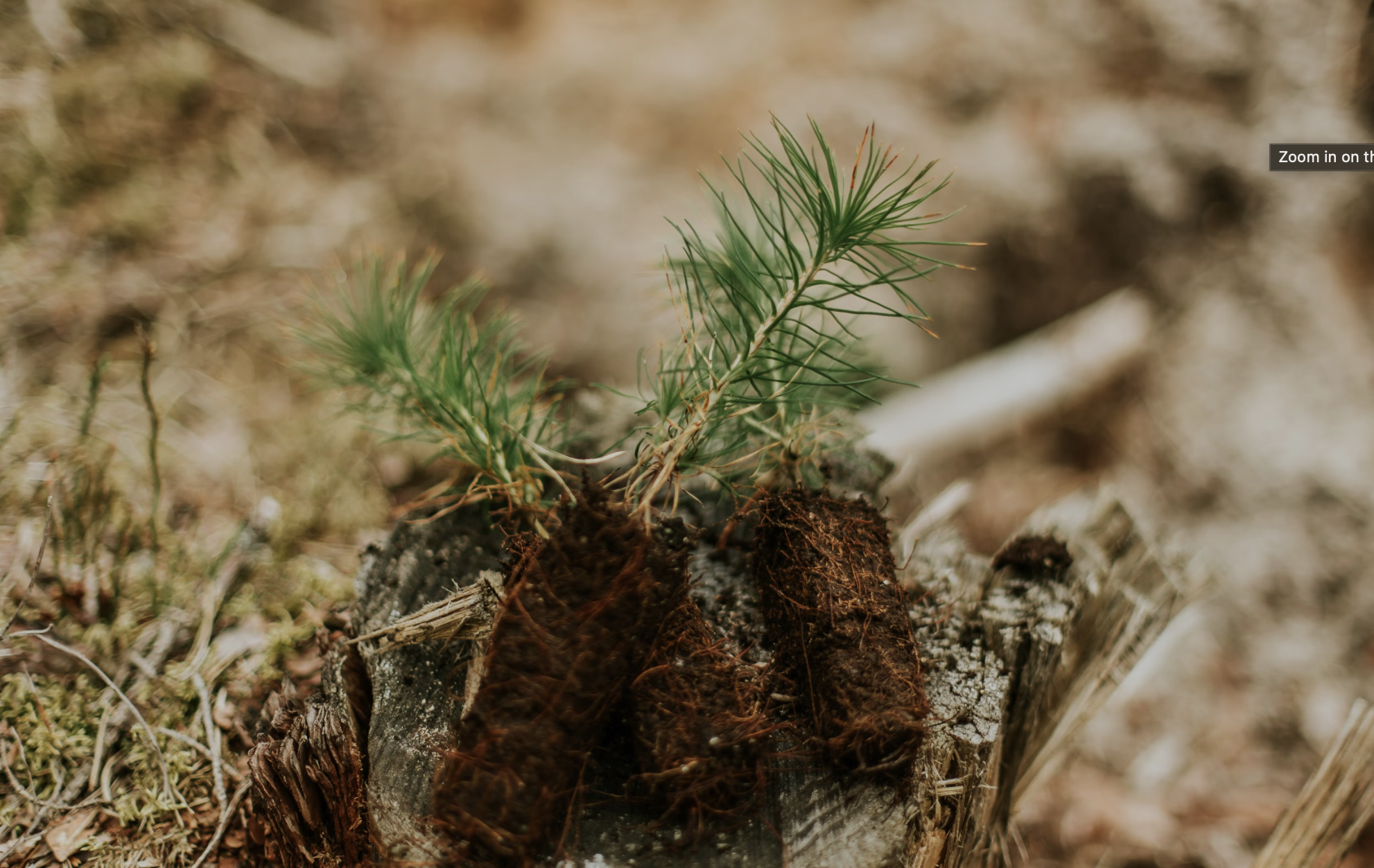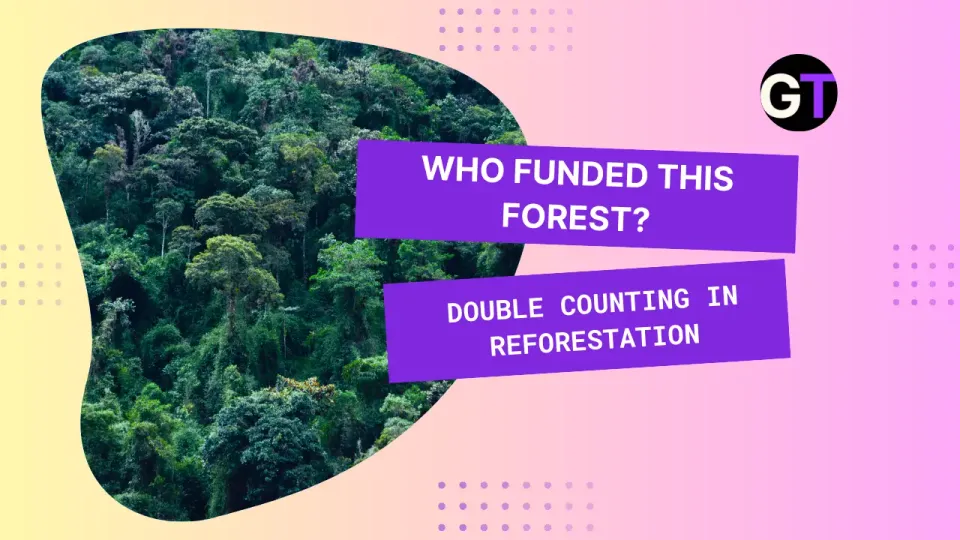Who's Keeping Score of How Many Trees We Plant?
Even just sorting out all the world’s various restoration commitments has proven difficult.

This article by Mike Gaworecki originally appeared in Mongabay.
- Nature-based climate solutions currently being widely touted include the restoration of the world’s degraded forests and other ecosystems in order to store more carbon. But while many restoration pledges have been made by many nations via many initiatives, the monitoring and tracking of their success remains murky.
- That’s because, while deforestation can easily be seen from satellites, effective and accurate ecosystem restoration tracking requires systems for long-term ground-truthing, for measuring carbon storage over decades, and for improvements in biodiversity and the boosting of local economies.
- Among the many ecosystem restoration initiatives now underway are the 2021 Glasgow Forest Declaration and the Bonn Challenge, along with the restoration commitments made as part of national emissions reductions plans under the Paris Climate Agreement (nationally determined contributions or NDCs).
- Strides toward better restoration tracking are being made by initiatives like the Bonn Challenge’s Restoration Barometer and the Brazilian Restoration and Reforestation Observatory — though more work is needed to secure globally accurate tracking.
In recent years, nature-based climate solutions, which seek to promote and enhance planet Earth’s innate ability to sequester carbon, have increasingly become an important strategy to mitigate global warming.
Ecosystem restoration, the process of bringing back ecological functionality in degraded ecosystems, is one nature-based solution that shows great promise, and it also seems to have worked its way into the public consciousness. Forest restoration, especially, has inspired people the world over to donate to, and participate in, various tree-planting initiatives, a simple and potentially effective means of combating climate change.
In fact, the benefits of restoring ecosystems are so clear, and so vital, that at the November COP26 summit in Scotland, 140 nations reaffirmed via the Glasgow Forest Declaration their “commitments to sustainable land use, and to the conservation, protection, sustainable management and restoration of forests, and other terrestrial ecosystems.”
The current decade (2021 to 2030) has also been declared the UN Decade on Ecosystem Restoration, with good reason: The United Nations Environment Programme notes that restoring 350 million hectares (or nearly 1.4 million square miles) of degraded land by 2030 could remove 13-26 gigatons of greenhouse gases from the atmosphere, while generating $9 trillion-worth in ecosystem services.
The Decade on Ecosystem Restoration is intended to function in conjunction with other global restoration goals, like those set by the Bonn Challenge in 2011, under which more than 60 countries have pledged to restore 210 million hectares (800,000 square miles) of degraded ecosystems, with the ultimate goal of restoring 350 million hectares by 2030. Regional restoration initiatives like Initiative 20×20 in Latin America and the AFR100 African Forest Landscape Restoration Initiative are also expected to get a boost from the UN Decade.

The challenge: Measuring ecosystem restoration
Unfortunately for our planet, it has been far easier for world leaders to make bold sweeping restoration pledges than it has for nations and NGOs to achieve and accurately measure results — a task proving to be far more complicated and daunting than at first expected.
It turns out not to be as simple as planting a million trees and watching them grow. Many tree-planting campaigns, for example, have prioritized the sheer number put in the ground, while underplaying provisions for planting the right trees in the right place and providing broad ecosystem services and livelihood benefits to local people — resulting in nothing more than a lot of loud initial publicity and money wasted on dead trees. (This 2021 Mongabay deep-dive into the body of research on reforestation’s effectiveness explores the complexities of planning a successful forest restoration.)
With so many audacious commitments now made, the world’s scientists, international groups and nations are asking just how much progress has truly been made towards meeting the world’s restoration goals? And what real impacts have those restoration interventions had on the environment and local livelihoods?
Those and other questions have no simple answers. Tracking restoration progress and monitoring the long-term impacts of restored ecosystems are complex tasks — but they’re vital responsibilities that many organizations and countries are beginning to tackle.
Tracking pledges
Even just sorting out all the world’s various restoration commitments has proven difficult. Many countries, for example, have pledged to restore forests under international frameworks like the Bonn Challenge and the New York Declaration on Forests, while also making restoration commitments as part of their emissions reductions plans under the Paris Climate Agreement (known as nationally determined contributions or NDC’s), or via mechanisms like the UN’s REDD+ initiative. But in many cases, countries have not followed up by releasing details on how they plan to honor their commitments, where and when restoration projects will happen, and actual results.
“The trouble you have when looking at these different policies and frameworks and the commitments being made, is it’s not very clear if the commitments are additional,” Charlotte Wheeler, a post-doctoral fellow at the Center for International Forestry Research (CIFOR), told Mongabay. “So you’re making a one million hectare [close to 4,000 square miles] commitment to the Bonn Challenge, and you’ve also got an NDC that has half a million hectares. Are they two separate commitments, or is that half million hectares part of the 1-million hectare commitment to the Bonn Challenge? There’s not a lot of transparency in a lot of the commitments being made, which makes it hard to fully understand exactly what countries are saying they’re going to do.”
In a commentary that Wheeler co-authored, published by Nature in 2019, she and her colleagues compiled every forest restoration commitment they could find made by 43 countries in the tropics and sub-tropics. Just 24 of those nations had released detailed plans for meeting their restoration commitments. Based on those available plans, the researchers determined that natural regenerationwould be employed to meet just 34% of pledges and agroforestry initiatives were planned for 21%, while the other 45% involved monoculture tree plantations — an approach frequently shown to diminish biodiversity, while meeting industrial commodity export needs rather than serving local communities.
The Nature authors also questioned the long-term carbon storage value of plantations. Because plantation forestry typically requires 10-20 year harvesting cycles, all the carbon sequestered on those tree farms, rather than being permanently stored, is released back into the atmosphere at the end of each cycle, failing to mitigate climate change. The scientists urged that policymakers, the restoration community and foresters focus in future on natural forest regeneration.
“I would say in defense of plantations, we do need them, and they are important. Timber plantations reduce pressure on native forests to produce timber resources; they produce important food crops,” Wheeler said. “But in lots of instances, I don’t think we can really consider them to be forest restoration solutions.”
The findings of Wheeler and her team demonstrate why the world urgently needs to track these commitments — in significant detail. After all, if the world’s nations are pursuing restoration projects unlikely to make substantial contributions to climate change mitigation, then policymakers need to know that, and to make course correction sooner rather than later. According to the UN Intergovernmental Panel on Climate Change (IPCC), “Without increased and urgent mitigation ambition in the coming years, leading to a sharp decline in greenhouse gas emissions by 2030, global warming will surpass 1.5°C [2.7°F] in the following decades, leading to irreversible loss of the most fragile ecosystems, and crisis after crisis for the most vulnerable people and societies.”

Tracking progress
Given the difficulty of simply evaluating the ecosystem restoration pledges nations have made across existing policy frameworks, it’s easy to understand why tracking on-the-ground progress towards meeting those commitments is even more frustratingly complex.
First off, lack of government transparency regarding restoration initiative implementation makes it hard to determine progress and, by default, to calculate just how much climate mitigation restoration efforts are achieving. Numerous technical limitations need to be overcome, as well.
Another area in need of improvement: restoration mapping. Surprisingly, while maps showing global tree-cover loss have been produced for years, there aren’t similar maps for global tree-cover gains.
“Forest loss has been pretty effectively monitored on a global scale for years, but restoration monitoring definitely lags compared to forest loss monitoring,” according to Jillian Gladstone, a senior consultant at the consultancy Climate Focus and coordinator of the Global Restoration Observatory (GRO), a multi-stakeholder initiative made up of restoration practitioners, data providers, trackers and monitoring platforms seeking to improve global restoration accountability efforts.
As for why tracking restoration systems are not nearly as robust as for forest loss, Gladstone responded: “I don’t think it’s received the same level of investment as forest loss, but also monitoring and reporting on restoration is definitely more complex than forest loss.”
She cites a few challenges inherent to restoration tracking, including the many divergent definitions of restoration and the large number of activities that need to be considered under the rubric of restoration.
Another challenge: Unlike rapid land-cover change, which is easily visible from space, forest restoration is a subtle and much more gradual process, taking decades before it’s detectable via traditional remote-sensing methods. Restoration needs to be tracked over long timescales, on-site, in order to detect quantitative and qualitative changes. However, most funders want to see quick, clearly visible conservation results (hence the prevalence of well-funded, high-profile tree-planting campaigns).
Another problem: how to track restoration on agricultural lands, including degraded cropland, pasture, and other areas outside of forests, areas not typically systematically monitored.
Overcoming these barriers is the Global Restoration Observatory network’s mission. “We’re working together to address those gaps that we see hindering comprehensive restoration monitoring by using a consultative, peer-reviewed approach to ensure consistency of methods, trying to increase data-sharing…, and to develop common indicators of restoration progress across organizations,” Gladstone said.
The network, she noted, is working to increase the impacts of existing restoration initiatives, including the UN Decade, Bonn Challenge, and national reporting on NDC’s. “Our goal is not to replicate or compete with anyone.… We’re really trying to just act as a convening platform to help these other initiatives meet their own goals.”
A tracking model: The Restoration Barometer
The Bonn Challenge has its own progress tracking tool, the Bonn Challenge Barometer, used since 2016 by some countries to track and honor their restoration pledges. Recently rebranded the Restoration Barometer, its capabilities have expanded to better meet the needs of countries attempting the byzantine task of tracking restoration project progress.
The Restoration Barometer is already in use by more than 20 countries, while 40 more have endorsed it, signaling intent to utilize it. And it’s just one tool in what’s becoming a fairly crowded field of global tracking toolkits, which also includes the World Resources Institute’s Land & Carbon Lab and RESTOR.eco, created by Crowther Lab at ETH Zurich.
Early in 2022, the expanded Restoration Barometer will become available to anyone, not just to Bonn Challenge pledgers, via a new website able to track terrestrial restoration interventions. Updates planned for later next year will extend the Barometer’s reach beyond the terrestrial realm, 50 meters (about 164 feet) offshore into the world’s oceans, allowing “ridge-to-reef” restoration tracking.
A key feature of the Restoration Barometer is its measurement of eight progress indicators, including a measure of success inclusive of restoration policies, funding channels, technical planning and in-country monitoring systems. Meanwhile, impact indicators include the total amount of land area under restoration, estimates of carbon sequestration, biodiversity benefits and economic boons such as job creation.
“There’s a plethora of new restoration monitoring platforms emerging, which is fantastic because everyone brings something slightly different,” Carole Saint-Laurent, head of the Bonn Challenge Secretariat and the IUCN’s Forest and Grassland team told Mongabay. “Many of them are geospatial based, which is great, but that [only] tells you whether the trees and vegetation are growing. The Barometer brings the additional piece [showing] why they are growing, [or] why they are not growing; why are we seeing changes in the landscape, [or] why are we not; are there some policies missing; has the technical planning not been done; is there not a restoration opportunities map somewhere? That’s maybe what distinguishes it from many other types of initiatives, which can all work hand-in-hand to give us the most comprehensive picture possible of progress.”

Restoration tracking in Brazil
At the national level, Brazil has perhaps the most robust restoration tracking system in place, through its Brazilian Restoration and Reforestation Observatory (BRRO), a joint effort by several organization (though it is not related to the Global Restoration Observatory, despite the similar names).
“It’s a challenge, because you don’t have publicly available data for restoration, you know?” Jefferson Ferreira, a WRI Brazil geographer who leads the organization’s work with the BRRO, told Mongabay. “It’s hard to get the detail, you have to contact all restoration initiatives you might know and ask for data. We have built a strong network of partners to do that.”
BRRO counts among its members several with active Brazilian restoration and monitoring initiatives, including the Atlantic Forest Pact and Alliance for Restoration in the Amazon. The BRRO acts as a national hub, collating data from regional restoration efforts, and also uses satellite imagery from Brazil’s MapBiomas project to track natural regeneration. To date, BRRO has tallied 79,000 hectares (305 square miles) of land currently under restoration, as well as nearly 11 million hectares of natural regeneration (more than 42,000 square miles), and 9.6 million hectares (37,000 square miles) of commercial plantations.
Some major gaps still exist in BRRO’s coverage, Ferreira said, though efforts are underway to address them. Chiefly, while the Atlantic Forest, Amazon, and Cerrado biomes of Brazil are covered, the BRRO presently gathers no data from the nation’s two other major biomes: the Pampas lowlands in southern Brazil or the Pantanal wetlands in western Brazil. But clearly, the restoration tracking that Brazil is now doing could serve as a model for other nations.
Other countries are striving to scale up their restoration tracking. Bernadette Arakwiye of WRI Africa is familiar with many African countries’ tracking systems (or lack thereof) because of her work with the AFR100 initiative, which 32 African nations have already joined, a program that aims to restore 100 million hectares (nearly 39,000 square miles) by 2030. She singles out Rwanda, Madagascar, and Niger as having some of the more advanced tracking systems in Africa so far, though both still face tracking and monitoring challenges.
And there’s a whole level of additional complexity to tracking progress made towards countries’ collective AFR100 pledges. “The initiative is going through [an analysis] process, and we should soon have guiding principles on how to report restoration progress at the initiative level. And moving forward the countries will be sharing their reported information,” she says.
With so much effort by so many organizations now going into ground-truthing and tracking the planet’s many initiatives, the world should soon have more solid metrics as to the effectiveness of implemented ecosystem restoration.

Citations:
Lewis, S. L., Wheeler, C. E., Mitchard, E. T., & Koch, A. (2019). Restoring natural forests is the best way to remove atmospheric carbon. doi:10.1038/d41586-019-01026-8
License
Gaworecki, M. (2021). Global Ecosystem Restoration Progress: How and Who’s Tracking It? Originally published in Mongabay. Available under a Creative Commons Attribution-ShareAlike 4.0 International License. Minor changes made to original title, formatting and images.




